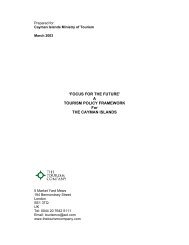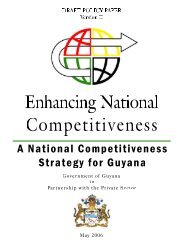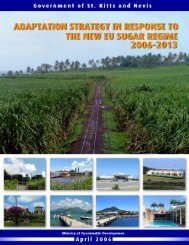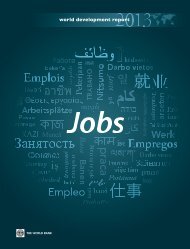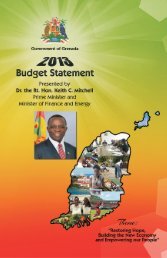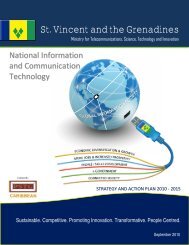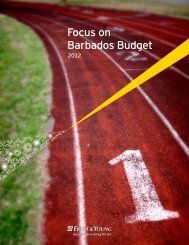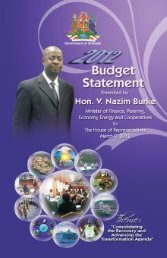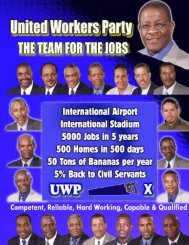Business Removing
Doing Business in 2005 -- Removing Obstacles to Growth
Doing Business in 2005 -- Removing Obstacles to Growth
- No tags were found...
You also want an ePaper? Increase the reach of your titles
YUMPU automatically turns print PDFs into web optimized ePapers that Google loves.
CLOSING A BUSINESS 69<br />
BOX 9.1<br />
Where is closing a business the most efficient—and where the least?<br />
Recovery rate<br />
(Cents on the dollar)<br />
Most<br />
Least<br />
Japan 92 Haiti 2<br />
Singapore 91 Angola 1<br />
Finland 90 Brazil 0<br />
Taiwan, China 90 Central African Republic 0<br />
Canada 89 Lao PDR 0<br />
Ireland 89 Chad 0<br />
Norway 88 Cambodia 0<br />
Netherlands 86 Bhutan 0<br />
Belgium 86 Rwanda 0<br />
United Kingdom 86 Madagascar 0<br />
Time to go through insolvency<br />
(Years)<br />
Fastest<br />
Slowest<br />
Ireland 0.41 Philippines 5.64<br />
Japan 0.54 Haiti 5.70<br />
Canada 0.75 Belarus 5.75<br />
Singapore 0.78 Indonesia 6.00<br />
Taiwan, China 0.79 Oman 7.00<br />
Norway 0.89 Mauritania 8.00<br />
Belgium 0.90 Czech Republic 9.17<br />
Finland 0.94 Brazil 10.00<br />
United Kingdom 1.00 Chad 10.00<br />
Spain 1.00 India 10.00<br />
Cost to go through insolvency<br />
(% of estate)<br />
Least<br />
Most<br />
Finland 1 Congo, Rep. 38<br />
Kuwait 1 Macedonia, FYR 38<br />
Netherlands 1 Panama 38<br />
Norway 1 Philippines 38<br />
Belgium 4 Sierra Leone 38<br />
Canada 4 United Arab Emirates 38<br />
Georgia 4 Venezuela 38<br />
Japan 4 Central African Republic 76<br />
Latvia 4 Chad 76<br />
New Zealand 4 Lao PDR 76<br />
Source: Doing <strong>Business</strong> database.<br />
Claimants—creditors, tax authorities, and employees—recover<br />
92 cents on the dollar from an insolvent firm in Japan,<br />
but only 7 cents in Romania. This is the result of three differences:<br />
the time spent closing down, the cost, and whether the<br />
firm survives as a going concern. In Japan the business is reorganized<br />
as a going concern under new management, without<br />
loss of value. 9 Official costs of the proceeding are 4%—reducing<br />
the available money to 96 cents. The reorganization<br />
takes 6 months, while the assets depreciate and claims are tied<br />
up at lending rates of 1.8% a year. The recovery rate is the<br />
present value of the proceeds—92 cents on the dollar. 10 The<br />
secured creditor has first priority and receives the full amount.<br />
In Romania the business starts rehabilitation proceedings but<br />
is eventually liquidated in parts—cutting the estate value from<br />
100 to 70. 11 This is reduced to 62 cents after paying 8% of the<br />
initial value in official costs. Assets depreciate and the claims<br />
are tied up for 4.6 years while the procedure is completed, at<br />
rates of 45% a year. The result—claimants collect 7 cents on<br />
the dollar. 12 The secured creditor is paid after taxes and labor<br />
claims.<br />
What drags the inefficient countries down? Delays. They account<br />
for half of the difference in the average rich and poor<br />
country’s recovery rates. Top performers resolve foreclosure<br />
or bankruptcy within a year. In 2004 Spain joined this list<br />
by introducing statutory time limits on procedures. Closing<br />
down takes the longest in South Asia, at 4.8 years. Latin America<br />
is second, at 3.6 years. Delays are 4 years in poor countries,<br />
twice as long as in rich countries. But there are notable exceptions<br />
in developing economies. Insolvency takes just over a<br />
year in Jamaica, Latvia and Tunisia.<br />
Whether the business keeps operating explains a third of the<br />
difference between rich and poor countries. Thirty-four countries<br />
typically keep the insolvent firm running. This includes<br />
Australia, Belgium and the Netherlands, as well as Thailand<br />
and Uganda. Over three quarters of OECD countries do. None<br />
in South Asia manage to. And only 4% of poor countries do.<br />
High administrative fees account for another 15% of the difference<br />
between rich and poor country’s recovery rates. Sub-<br />
Saharan African and East Asian countries have the highest<br />
costs, at over 20% of the bankruptcy estate. Except Israel, no<br />
rich economy has such high costs.<br />
The recovery rate is calculated at the time of entry into bankruptcy<br />
or foreclosure proceedings. In some countries—such<br />
as the Nordics—management must announce insolvency.<br />
Creditors can trigger insolvency proceedings immediately before<br />
more value is lost. But in many others, the debtor can<br />
hide insolvency, and creditors cannot initiate proceedings. In<br />
such cases the value of the firm will shrink even before the<br />
proceedings start.



